Ironbark Zinc (ASX: IBG, Share Price: $0.12, Market Cap: $51m) is the first pure zinc exposure that we have incorporated into our Portfolio since we began way back in December 2010. The rationale for this has been quite clear – zinc has until recently been a poor-performer from a pricing perspective – hence there has been no sound reason to this point to recommend zinc equities. Nevertheless, we have covered zinc extensively from a sector perspective and we have consistently highlighted the looming supply gap that would emerge. We are now approaching a critical point in terms of declining supplies from existing zinc sources, which we believe justifies the introduction of a world-class emerging zinc producer.
Ironbark Zinc is one of the few new emerging sources of significant zinc supply anywhere in the world and after charting the company’s progress for many years, I now believe the time is right to buy-in.
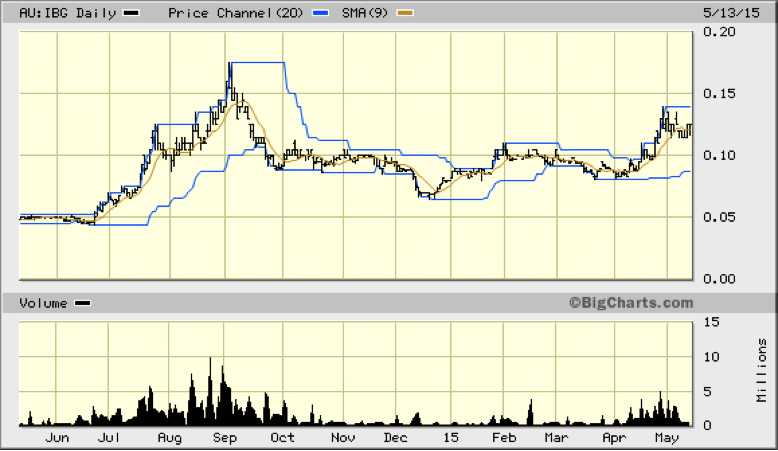
Market Significance
We’re beginning to see solid zinc price movement, supported by draw-downs in London Metal Exchange (LME) inventories. It is likely that the zinc supply imbalance will increase over the coming years, further supporting prices. In the near-term, we will see the closure of the large Century (Australia) and Lisheen (Ireland) zinc mines during 2015. Essentially, decades of under-investment in the zinc industry (a metal often seen as problematic by investors) has provided a window of opportunity for Ironbark, with its Citronen zinc project being one of the world’s largest and currently at an advanced post-feasibility stage.
Investment Overview
Ironbark isn’t a new story – in fact the company was listed on the ASX way back in 2006. I recall having many meetings in the past with the company’s Managing Director, Jonathan Downes, who had always outlined a very patient, measured and thorough approach to project advancement and ultimately the company’s goal of achieving production status. The major problem for Ironbark (and a host of other junior companies) was the GFC, which hampered funding efforts and put a lid on commodity prices, particularly zinc. However, nearly a decade later – I believe Ironbark’s time has arrived.
Probably the most compelling argument for zinc is not the price chart, but the LME chart of inventories below. At the end of the day it’s not rocket science, as declining stockpiles directly reflect both increased demand but more importantly supply-side issues related to the closure of ageing mines. It’s a situation that’s been coming for the past half-dozen years, but the consequences of which have been delayed by the impact of the GFC and more recently China’s economic slowdown.
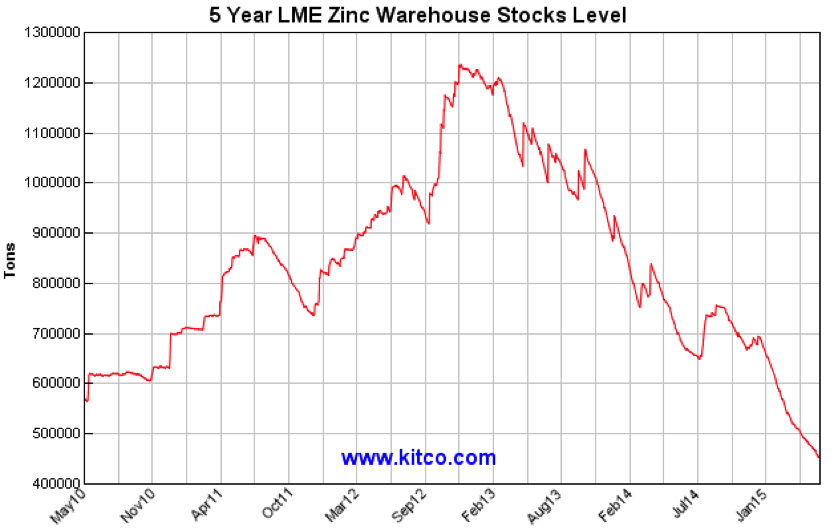
The consequences of declining inventories are clearly reflected in the 12-month zinc price chart below, with prices in May consolidating after a stellar start to 2015 that has made zinc the best-performing metal.
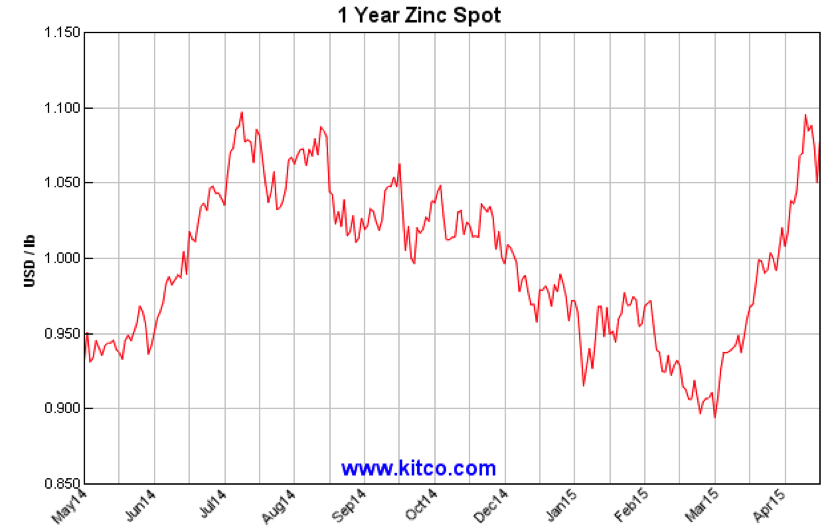
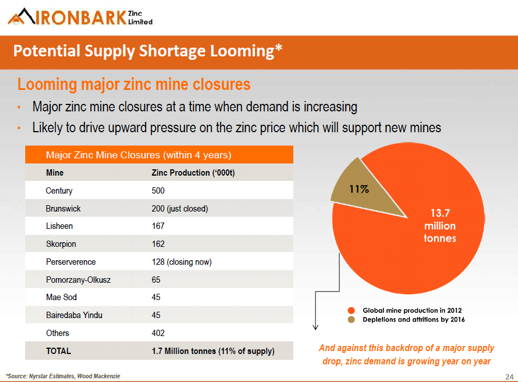
Ironbark’s key attraction is that it is one of the few junior companies anywhere in the world that retains 100% ownership of a world-class zinc asset. This means that it is attractive as an option on the zinc price, as well as retaining strong corporate appeal.
The 100%-owned Citronen zinc-lead project in northern Greenland represents one of the world’s largest undeveloped zinc-lead deposits, with a resource in excess of 13 billion pounds of contained zinc and lead metal. So far Ironbark has spent $50 million on the project, including more than 67,000 metres of diamond drilling. The mineralisation at Citronen starts from surface, is flat-lying and is currently open in almost all directions. The deposit is adjacent to a deep water fjord that provides near-mine ship docking and loading opportunities.
Ironbark maintains an MOU with China Nonferrous (NFC) that provides for an EPC lump-sum, fixed-priced construction and commissioning contract, with an associated 70% debt funding and 20% direct project investment (total 90%). The company is continuing to keep its options open with respect to project funding alternatives.
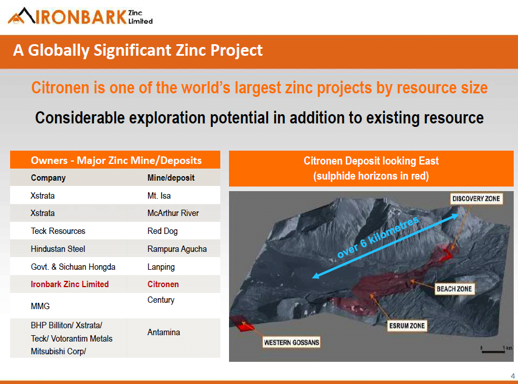
Key points – 2013 Citronen Feasibility Report
• NPV: US$609 million (US$354M post tax)
• IRR: 32.0% (22.2% post tax)
• Equity Return: 37.9% (Geared NPV after tax)
• Capital Cost: US$429.3 million inc contingency (US$484.8M with First Fills)
• Operating Cost: US$0.59/lb Zn (Payable, Net of by-product credits, Years 1-5, Smelter fees additional US$0.12/lb Zn)
• Mine Life: 14 years
• Life of Mine Operating Costs: US$3.42 billion
• Life of Mine Revenue: US$5.65 billion
• Payback Period: 18 months
Latest Project Activity
Progress during the recent quarter has been steady with respect to the Citronen Exploitation Licence Application (Mining Licence Application). The Greenland Government has recently undergone significant change with new Ministers appointed across a range of Ministries and responsibility for the permitting now spread across three of these ministries. Meetings were held with Mr. Andreas Uldum, the Minister for Ministry of Mineral Resources, in Canada when Ironbark presented on behalf of the Greenland Day promotion at the Prospectors and Developers Association of Canada (PDAC).
Meetings were also held in Greenland with Mr. Mala Høy Kúko the Minister for the Ministry of Nature, Environment and Justice and Mr. Vittus Qujaukitsoq the Minister for the Ministry of Industry, Labour and Trade. The meetings were positive and constructive with strong support across the three relevant Ministries for the Citronen development.
Ironbark also received an update from the Environment Agency for Mineral Resources Activities – Danish Centre for Environment and Energy (DCE) regarding the Mining Licence Application. The DCE review of Ironbark’s Environmental Impact Assessment (EIA) found that all environmental issues have been treated satisfactorily in the EIA. In addition, the final Danish Maritime Assessment (DMA) was lodged and the Mine Closure Plan was completed and ready to be submitted.
Once formal approval of the SIA has been granted Ironbark will move to manage a public consultation process and to enter into an Impact Benefit Agreement (IBA). The IBA is a document used to provide a formal framework for Ironbark’s obligations under the SIA such as training and employment commitments to the Greenlandic people. The Ministry of Industry, Labour and Trade is also currently working on the IBA.
Following approval, the Mining Licence would provide Ironbark with the right to mine at Citronen for a period of 30 years.
Importantly, Greenland is seeking to develop a strong mineral and petroleum industry and has returned very high global rankings on the annual Fraser Institute survey. Zinc and lead minerals have been approved for exploitation in Greenland, which has a history of zinc and lead mining and continues to seek to re-establish a mining industry.
Ironbark is also working with China Nonferrous on construction and financing solutions for the development of Citronen. The company is currently operating under a Memorandum of Understanding and is advancing this through to a detailed scope of works.
Summary
As we commented at the outset, Ironbark Zinc is in the right place at the right time. It’s been a long time coming, but we’re finally beginning to see the realization of the zinc supply shortage that has been looming for the best part of a decade. Investors typically fail to appreciate the gravity of such supply-side issues until it’s too late – i.e. until inventory falls generate associated price increases and the herd begins to take notice of rising equity prices. The dampening effects of the GFC have delayed the inevitable, but supply issues are beginning to be realized. Ironbark’s Citronen zinc project is one of the world’s largest and hence provides strong leverage to future zinc prices – as well as corporate appeal. We recommend Ironbark Zinc as a Speculative Buy around $0.12.







